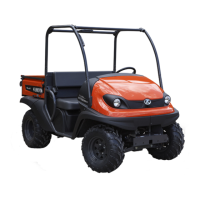PERIODIC SERVICE50
BChecking Fuel Line
To avoid personal injury:
A Be sure to stop the engine and remove the key
when attempting to make the following checks
and changes.
A Never fail to check the fuel lines periodically.
The fuel lines are subject to wear and aging.
Fuel may leak out onto the running engine,
causing a fire.
The fuel line connections should be checked annually or
every 100 service hours, whichever comes first.
1. Park the vehicle on a flat surface and raise the cargo
bed.
2. The fuel line is made of rubber and ages regardless of
service period.
3. If the fuel line and clamps are found to be damaged or
deteriorated, replace them.
A When the fuel line is disconnected for maintenance or
repair, close both ends of the fuel line with a piece of
clean cloth or paper to prevent dust and dirt from
entering. In addition, particular care must be taken not
to admit dust and dirt into the fuel pump. Entrance of
even a small amount of dust or dirt cause premature
wear and malfunction of the fuel pump and injector
components.
(1) Fuel line (Fuel tank Throttle body)
(2) Hose clamp
(A) Throttle body
(1) Fuel line (Carbon canister Throttle body)
(2) Hose clamp
(A) Throttle body
(1) Fuel line (Fuel pump Throttle body)
(2) Hose clamp
(3) Fuel pump with filter
(1) Fuel line (One way valve Carbon canister)
(2) Fuel line (Three way connector One way valve)
(3) Fuel line (Fuel tank Three way connector)
(4) Fuel line (Carbon canister Throttle body)
(5) Hose clamp
(A) Carbon canister
(B) One way valve
(C) Three way connector

